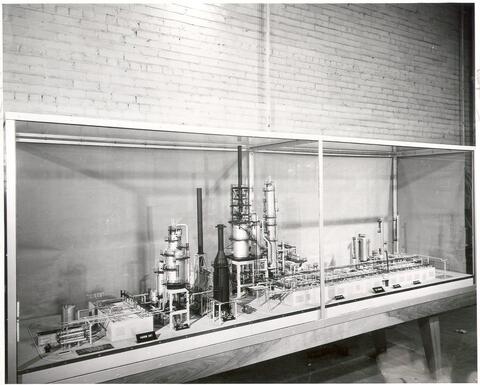
Área de título y declaración de responsabilidad
Título apropiado
Petroleum Engineering - "Cat Cracker" Model
Tipo general de material
- Graphic material
Título paralelo
Otra información de título
Título declaración de responsabilidad
Título notas
Nivel de descripción
Item
Institución archivística
Código de referencia
Área de edición
Declaración de edición
Declaración de responsabilidad de edición
Área de detalles específicos de la clase de material
Mención de la escala (cartográfica)
Mención de proyección (cartográfica)
Mención de coordenadas (cartográfica)
Mención de la escala (arquitectónica)
Jurisdicción de emisión y denominación (filatélico)
Área de fechas de creación
Fecha(s)
-
1955 (Criação)
Área de descripción física
Descripción física
1 photograph : b&w ; 20 x 24 cm
Área de series editoriales
Título apropiado de las series del editor
Títulos paralelos de serie editorial
Otra información de título de las series editoriales
Declaración de responsabilidad relativa a las series editoriales
Numeración dentro de la serie editorial
Nota en las series editoriales
Área de descripción del archivo
Nombre del productor
Historial de custodia
Alcance y contenido
Image of a cat-cracker-model relating to Petroleum Engineering.
Área de notas
Condiciones físicas
Origen del ingreso
Arreglo
Idioma del material
Escritura del material
Ubicación de los originales
Disponibilidad de otros formatos
Restricciones de acceso
Condiciones de uso, reproducción, y publicación
Photographer: Saskatoon Star-Phoenix
Copyright: Saskatoon Star-Phoenix
Instrumentos de descripción
Materiales asociados
Acumulaciones
Nota general
From Star-Phoenix article on back of image: "Petroleum Engineering - a new branch in the College of Engineering - is being introduced at the University of Saskatchewan for the 1955-1956 term. The new branch will take its place along with the other seven branches of engineering: agricultural, chemical, civil, electrical, geological, mechanical and engineering physics. The university's first appointment in the branch is assistant professor R.B. Shearn, a graduate of the University of Birmingham. The course is designed for the student intending to engage in the engineering phases of the production of oil and gas, rather than the exploration and geological work to do with the searching and development of oil and gas fields. Students who have satisfactorily completed the third year in chemical engineering or geological engineering will be admitted to a final fourth year in petroleum engineering. Because of the differences in the first three years of training, part of the work will differ for the two groups. Both will, on graduation, have a similar amount of engineering training, but one will have a broader knowledge of chemistry and the other of geology. Either is quite satisfactory for this field of engineering and allows for later specilization, if desired. Imperial Oil Ltd. presented a model of a modern oil refinery to the engineering college in November. The model is of the latest fluid catalytic cracking unit and vacuum distillation unit of the Regina plant. The model is built on a scale of 1/4 inch to the foot. It measures six feet by twwn feet and is approximately four feet high. These units formed the magjor part of an expansion program which was two years in the building and cost more than $7 million. The model is valued at $5,000. The model travelled to Saskatoon in a special moving van on a six-inch thickness of felt padding. On top of this were inflated rubber tubes, covered by a 700 pound sheet of boiler plate. On top of it were more pads and a huge sheet of sponge rubber. The model sat on a wooden frame and was held down by robes attached to large coil springs. Old tires were placed between the walls of the van and the model. These precautions were necessary to prevent the vibration from shaking the balsa wood and plastic to pieces. The high towers of the model were braced with wood, heavy cord and adhesive tape. The model is not a show piece but for practical demonstration purposes in the college."

